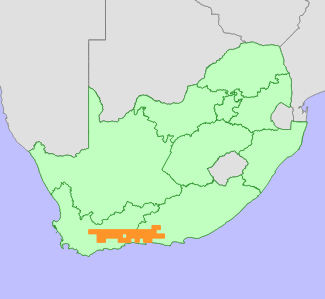|
Scientific Name | Leucospermum wittebergense Compton |
Higher Classification | Dicotyledons |
Family | PROTEACEAE |
Common Names | Swartberg Pincushion (e) |
National Status |
Status and Criteria | Least Concern |
Assessment Date | 2019/06/25 |
Assessor(s) | A.G. Rebelo, H. Mtshali & L. von Staden |
Justification | Leucospermum wittebergense is widespread, common and not in danger of extinction. It is therefore assessed as Least Concern. |
Distribution |
Endemism | South African endemic |
Provincial distribution | Eastern Cape, Western Cape |
Range | This species is widespread in the mountains of the southern Western Cape, extending to the Eastern Cape. It occurs from the Witteberg near Touwsrivier eastwards to the Kouga Mountains and Grootrivier Mountains in the Steytlerville district. |
Habitat and Ecology |
Major system | Terrestrial |
Major habitats | South Rooiberg Sandstone Fynbos, Swartberg Shale Fynbos, Matjiesfontein Quartzite Fynbos, Grootrivier Quartzite Fynbos, North Langeberg Sandstone Fynbos, South Langeberg Sandstone Fynbos, North Outeniqua Sandstone Fynbos, South Outeniqua Sandstone Fynbos, Matjiesfontein Shale Fynbos, North Rooiberg Sandstone Fynbos, Swartberg Shale Renosterveld, North Swartberg Sandstone Fynbos, South Swartberg Sandstone Fynbos, North Kammanassie Sandstone Fynbos, South Kammanassie Sandstone Fynbos, Kouga Sandstone Fynbos, Kouga Grassy Sandstone Fynbos, Kango Conglomerate Fynbos, Tsitsikamma Sandstone Fynbos |
Description | It occurs predominantly on arid, rocky sandstone or quartzitic slopes, more rarely on sandstone-shale ecotones, 300-1800 m. Mature individuals are killed by fires, and only seeds survive. Seeds are released after ripening, and dispersed by ants to their underground nests, where they are protected from predation and fire. It is pollinated by birds. |
Threats |
| As a reseeder, Leucospermum wittebergense is potentially vulnerable to too frequent fires, which can cause local extinctions if fires repeatedly kill individuals before they are reproductively mature. Field observations noted too frequent fires occurring in the Swartberg and Baviaanskloof, but no loss of subpopulations have yet been recorded.
It is also potentially threatened by competition from alien invasive plants at some localities in the Swartberg, Outeniqua Mountains and Baviaanskloof. |
Population |
This species is common across its range, occurring in large subpopulations. As there are no severe threats, the population is not suspected to be declining.
|
Population trend | Stable |
Assessment History |
Taxon assessed |
Status and Criteria |
Citation/Red List version | | Leucospermum wittebergense Compton | Least Concern | Raimondo et al. (2009) | |
Bibliography |
Goldblatt, P. and Manning, J.C. 2000. Cape Plants: A conspectus of the Cape Flora of South Africa. Strelitzia 9. National Botanical Institute, Cape Town.
Raimondo, D., von Staden, L., Foden, W., Victor, J.E., Helme, N.A., Turner, R.C., Kamundi, D.A. and Manyama, P.A. 2009. Red List of South African Plants. Strelitzia 25. South African National Biodiversity Institute, Pretoria.
Rebelo, T. 2001. Sasol Proteas: A field guide to the proteas of southern Africa. (2nd ed.). Fernwood Press, Vlaeberg, Cape Town.
Vlok, J. and Schutte-Vlok, A.L. 2010. Plants of the Klein Karoo. Umdaus Press, Hatfield.
|
Citation |
| Rebelo, A.G., Mtshali, H. & von Staden, L. 2019. Leucospermum wittebergense Compton. National Assessment: Red List of South African Plants version . Accessed on 2025/07/07 |
 Comment on this assessment
Comment on this assessment

